10 Pound Backpack to Hike 100 Miles
That’s the total weight of everything in my backpack—gear, food, water, and stove fuel. I used that 10 pound backpack to hike 100 miles (plus a few more) of the Appalachian Trail through Shenandoah National Park in 3 days. No fair weather hiking, it was more late winter than early spring conditions—rain, sleet, light snow and hard freezes at night. I think I am very close to dialing in a Light Pack that is also supremely efficient at covering long trail miles*.
But more important, I thoroughly enjoyed myself. I was warm, happy and comfortably cruising along one of the most spectacular ridge lines on the east. The kooky weather made for great entertainment and some spectacular views. (Scan through the photos below for a few of them.)
| * Anyone can adopt the techniques I used to reduce wasted time and become a more efficient hiker. Even if long trail miles is not your goal, this gives you more time to enjoy the great views, take photographs, fish, or get some extra swimming in a lake rather than fiddling with your gear. |
And just to be clear: My 34 miles/day average on the AT through Shenandoah National Park is far from super speedy. The fabulous Heather (Anish) Anderson averaged 42 miles per day on her record setting, unsupported AT through-hike last year. And my guess is that each year, more than a few hardy through-hikers cover the Park in 3 days as well. Nonetheless, I’m happy with my hike given the unusually cool and wet weather and short daylight hours of early April.
This a three part series:
- My 2007 attempt to section hike the 102 miles of the AT Trail through Shenandoah National Park in three days (I came up short)
- My March 2016 plans: Practical Light Gear List Appalachian Trail to use better gear and techniques
- And this April 2016 report of my successful completion of the 102 miles of the AT in SNP in three days.
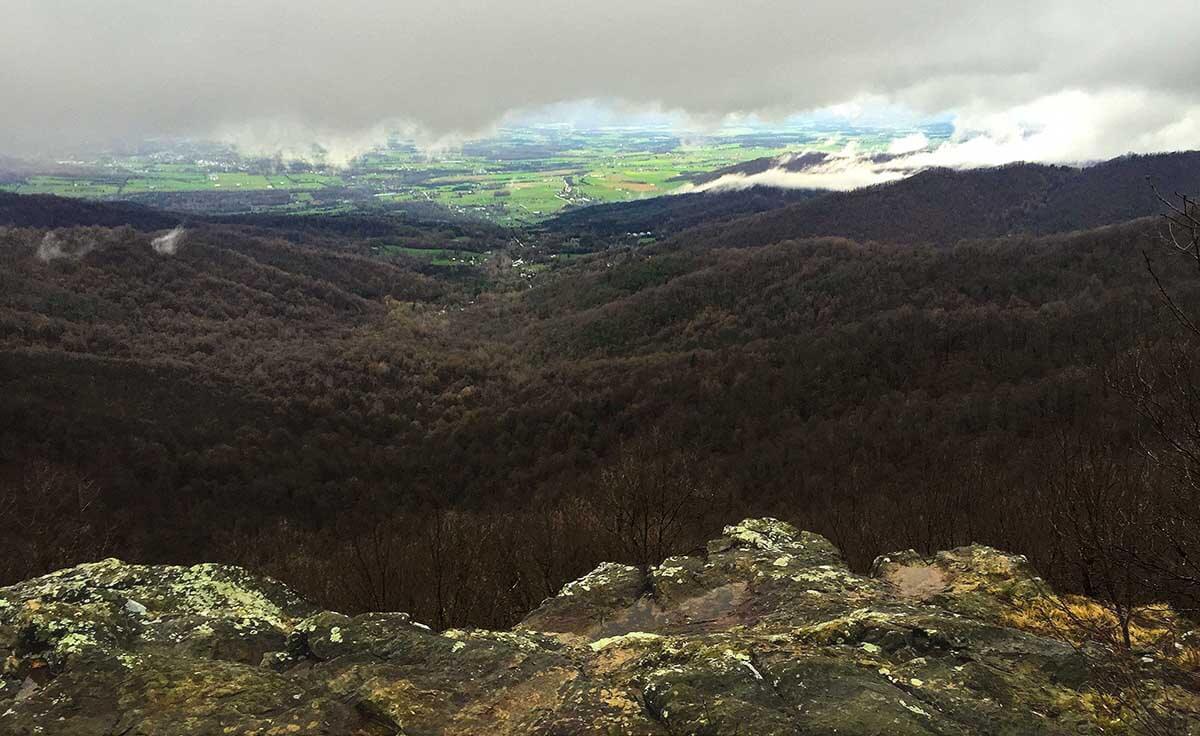
Lots of kooky weather created some spectacular views. That’s the Shenandoah Valley almost 3,000 feet below me.
Why it Worked this Time – 10 Pound Backpack to Hike 100 Miles
In previous posts, I’ve discussed coming up short in my 2007 attempt to section hike the 102 miles and 22,000 feet of elevation gain of the Appalachian Trail through Shenandoah National Park in 3 days. So what were the keys to succeed this time even though the weather was more challenging:
- Focus on efficiency—no wasting time: Running out of daylight was the major reason why I came up short in 2007. Minutes matter. Less wasted time equals more time to hike in the limited daylight of early spring. Just a few minutes wasted per hour adds up to 10 miles over 3 days.
- Gear: I chose practical but light gear, with a focus on zero fiddle-factor (= no time wasting).
For a full discussion of this as well as the gear list see: Practical Light Gear List Appalachian Trail - In this post I discuss two major gear choices, my 11 oz backpack and my 2.8 lb sleep system, and how they contributed to the efficiency (lack of time wasting) of my hike.
- Adjustments for crap weather: As they say, “when we make plans Nature laughs.” Here’s the last minute gear adjustments I made for unusually wet and cold trip weather: Major Adjustments for Cold Weather
- Shakedown trip: Two weekends prior, Alison and I did a 3 day Early Spring Backpacking Trip in cold and wet conditions with the gear I intended to use on the hike. On that trip we put in a hard and fast 22 mile day. In addition, in previous winters I tested my very cold weather hammock gear at 12°F (-11°C) so I had a tried and true light winter hammock quilt system ready to go.
- Food: I used my usual 3-day-trip strategy—bring a small amount of very high calorie and nutritious food. I ate a huge breakfast before I started hiking on day 1, and a huge dinner when I came out on day 3. To save time, I ate much of my food while walking. See: Best Backpacking Food – simple and nutritious – veggie and omnivore friendly
- Water: I drank when thirsty following current advice from experts in the field of sports hydration. The AT with its frequent springs and streams lends itself to a drink at source and not carry water strategy. I was not thirsty between water sources. But more important, I spent less time collecting/purifying water and making fewer side trips to springs (= more time to hike). I felt healthy and fine and woke each day ready to hike another 34 miles. See: Drink When Thirsty – Myths and Facts about Hydration.
- Training: Listed next to last, but certainly among the most important contributors to trip success. It was critical to be in good hiking shape from the get-go; I didn’t have the luxury of hiking 850 trail miles to season-up, like North Bound through-hikers that started at Springer Mountain, GA. I followed my own 2 day a week training schedule, Quick and Efficient Training for Backpacking. I couldn’t, in training, match my longest expected day (36 miles with 15,000 feet of elevation change). I did my best with a a few fast and hilly 20+ mile hikes pre trip.
- Fun: And last but certainly most important is enjoying the trip. Yes, I had fun. Sometimes more “fun” than I wanted, but for the most part I thoroughly enjoyed myself. The Blue Ridge put on a spectacular show with weather fronts rolling through. With more time, I would have happily picked up food in Waynesboro and kept on heading south.
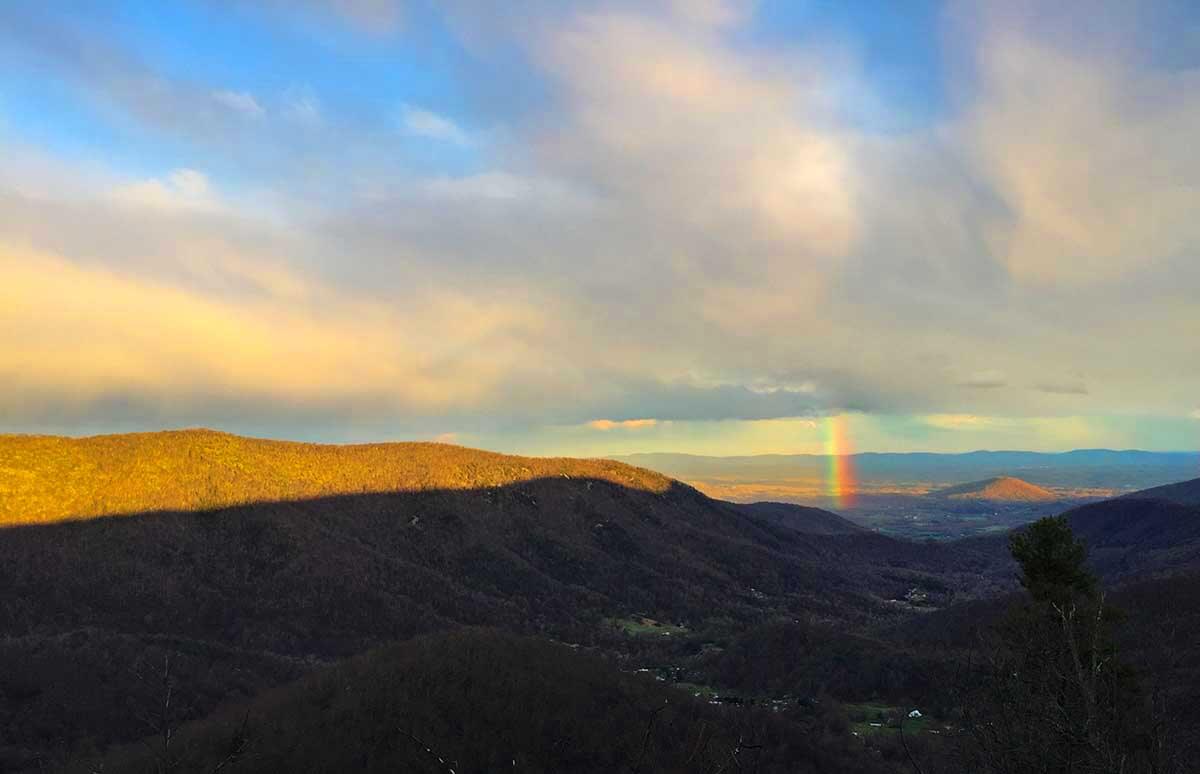
Rain sometimes brings dramatic views. A late evening squall passes over me, heading east towards Washington DC. It’s nowhere near as warm as it looks. Much of the squall was horizontal sleet.
Efficiency – No Time Wasting
Running out of daylight was the major reason why I came up short in 2007. While you can hike in the dark under headlamp it is neither as fast nor as efficient as hiking in daylight. Rather, you have to slow down to miss rocks and other irregularities in the trail. In addition, it is much harder to follow the trail after dark. It is also easy to loose the trail—and re-finding the trail is a huge loss of time. That’s why all the speed records on the AT are done in the middle of the summer with the most daylight.
Minutes matter. This overarching goal trumps everything else. Less wasted time equals more time to hike in the limited daylight of early spring. Just a few minutes wasted per hour can add up to 10 miles over 3 days. So I did whatever I could do with gear choices and technique to be hiking as much as possible during each hour, and spending the least amount of time stopped or fiddling with things.
Note: time wasting has far more universal impacts than just trying to make trail miles. For instance, if you’ve just spent a lot of money and your precious vacation time to take a big trip, wouldn’t you rather spend your time enjoying the great views, taking photographs, fishing, or getting some extra swimming in a lake rather than fiddling with your gear? I will cover this topic, “Backpacking Time Wasters and Time Savers” in an upcoming post.
Gear – 10 Pound Backpack to Hike 100 Miles
This is not a fringe gear list. I want to be safe. I hate being wet, cold and uncomfortable. I want a good night’s sleep. This gear list does all of that. In fact I’d wager that I am warmer, more comfortable, have more living area, and sleep better than most campers. For a complete discussion on gear selection and a Complete Gear List see my previous post: Practical Light Gear List Appalachian Trail.
Each minute of daylight hiking time is precious and once squandered cannot be recovered. As such I chose practical but light gear, with a focus on zero fiddle-factor (time wasting). If gear was lighter but took away from my hiking time (or sleeping time) it was out. I’ll use my backpack and sleep system selection rationale as examples.
Backpack
- The Mountain Laurel Designs Burn Backpack’s Cuben Fiber construction is plenty durable. I don’t have to waste time trying to handle it gently, or to not scrape it against brush or rocks. (vs. the single rear pocket, no hipbelt, 3.8 ounce spinnaker fabric pack I used in 2007)
- The Burn’s numerous pockets save time as I rarely need to take the pack off to get what I need. Most often, I can do this while continuing to walk. From the two side pockets and two shoulder strap pockets, I can instantly access my most-used-gear and all of my day’s food. Rainwear is in the rear pocket and accessible in less than 10 seconds. Most days I don’t need to go into the main pack-bag during the day—which is good since that’s a lot of time wasted.
- The Cuben Fiber main pack-bag with a roll top closure is virtually waterproof. Combine that with stowing my quilts and down jacket in Cuben Fiber stuff sacks and I don’t need to do anything different when it rains, just keep hiking. So my backpack is always packed the same, regardless of weather. No messing around taking on and off pack covers (imperfect rain protection anyway) or fussing with pack liners, both of which are a pain and waste time.
- It has a simple and light hipbelt capable of supporting at least 15 to 20 pounds.
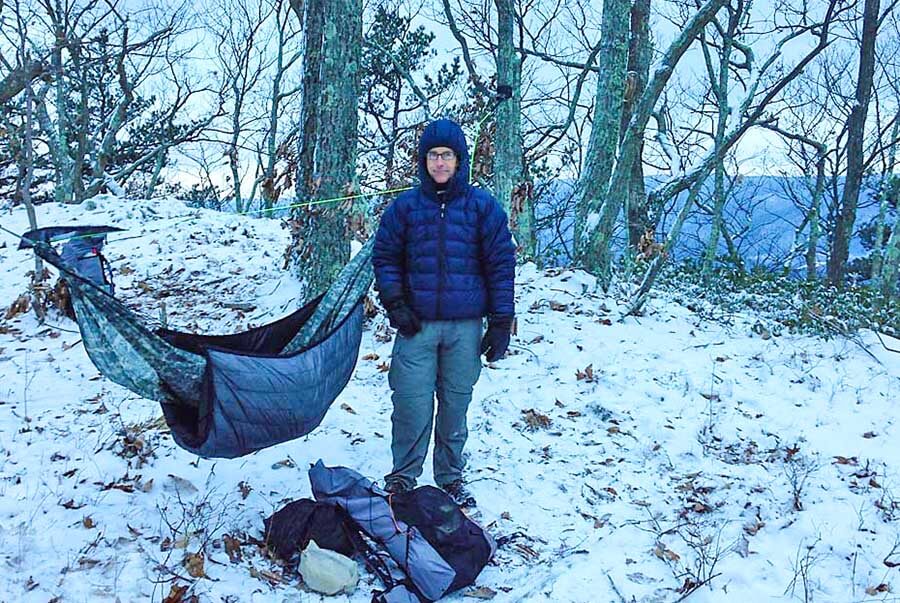
Fortunately, in previous winter trips I had tested my very cold weather hammock gear down to 12°F (-11°C). So I had a solid and very light winter hammock quilt system ready to go. One I had complete confidence would give me a great night’s sleep.
Sleeping System
- Getting a good night’s sleep was essential to putting in back to back long days on the trail. My body needed rest to recover and get up and do it all over again the next day. Any impediment to getting my recovery was “time wasted.” This was arguably more important than wasted hiking time.
- I need a light sleep system that I know will give me great sleep every night! One that I will relax and start to doze off minutes after I lie down and know that I will sleep soundly for the rest of the night.
- For me on the AT this is clearly an 8 oz hammock paired with warm down quilts and a cuben fiber tarp. Read more here: Hammock camping article. Hammock Camping Part I: Advantages & disadvantages versus ground systems
- Another advantage of a hammock on the AT, hammock camping equates to more miles hiked at the end of the day vs. sleeping on the ground.
- Why? Sleeping in a hammock dramatically increases suitable campsites on the AT. With a hammock all I need to camp is two trees—the ground below is largely irrelevant. That means I can hike until dusk without the risk of being in un-campable terrain. (Since much of the AT is sloped and rocky it’s not suitable for ground camping.)
- So if I were ground sleeping I would likely need to stop hiking sooner than dusk to camp. I.e. I need to stop at the last shelter or campground that I could comfortably make before dark. Thus I might miss an hour or more of available daylight to hike.
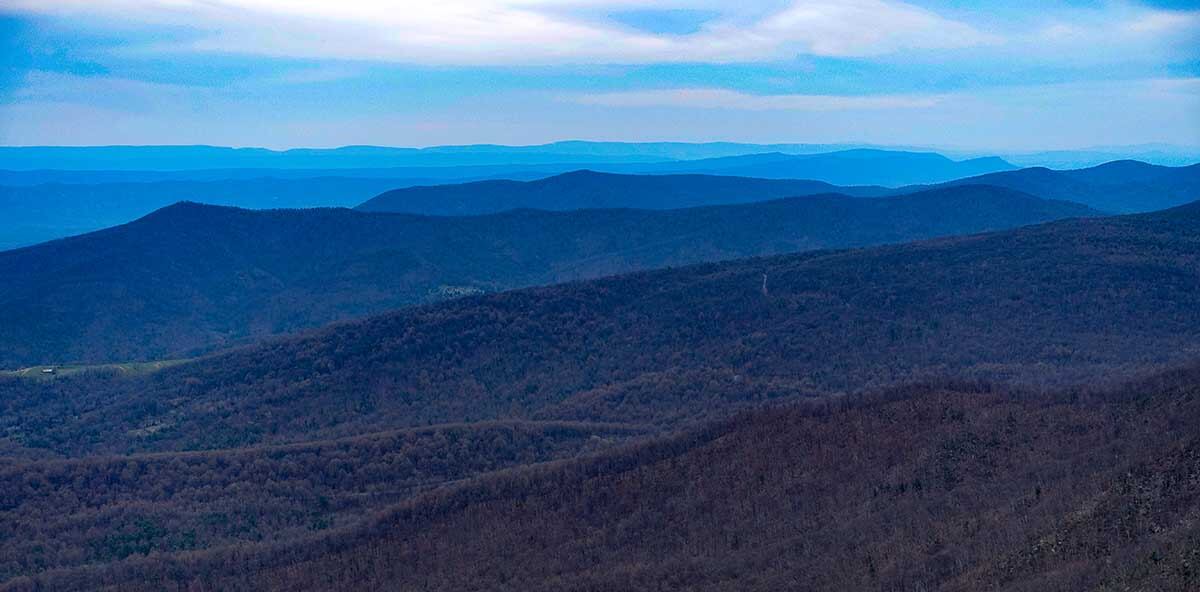
Blue Ridge at dawn
Adjustments for Challenging Weather – when we make plans Nature laughs
I was hoping for pleasant spring conditions—sunny and in the 60s during the day with crisp sleeping temps in the 40s at night. Unfortunately, this was the weather I got. It would be even colder than this at higher elevations along the Blue Ridge in the park with temperatures likely dropping into the low 20s and rain becoming wind-blown sleet. Life is like that sometimes.
My major changes were:
- do the hike in 3 vs. 4 days
- take warmer, +20F hammock quilts but with trimmer dimensions to save weight
- take a bit warmer clothes; a down jacket vs. down vest, and to add a light fleece shirt that I wore the whole hike.
Click here to see Major Changes for Winter Wx full page, as a Google Sheet
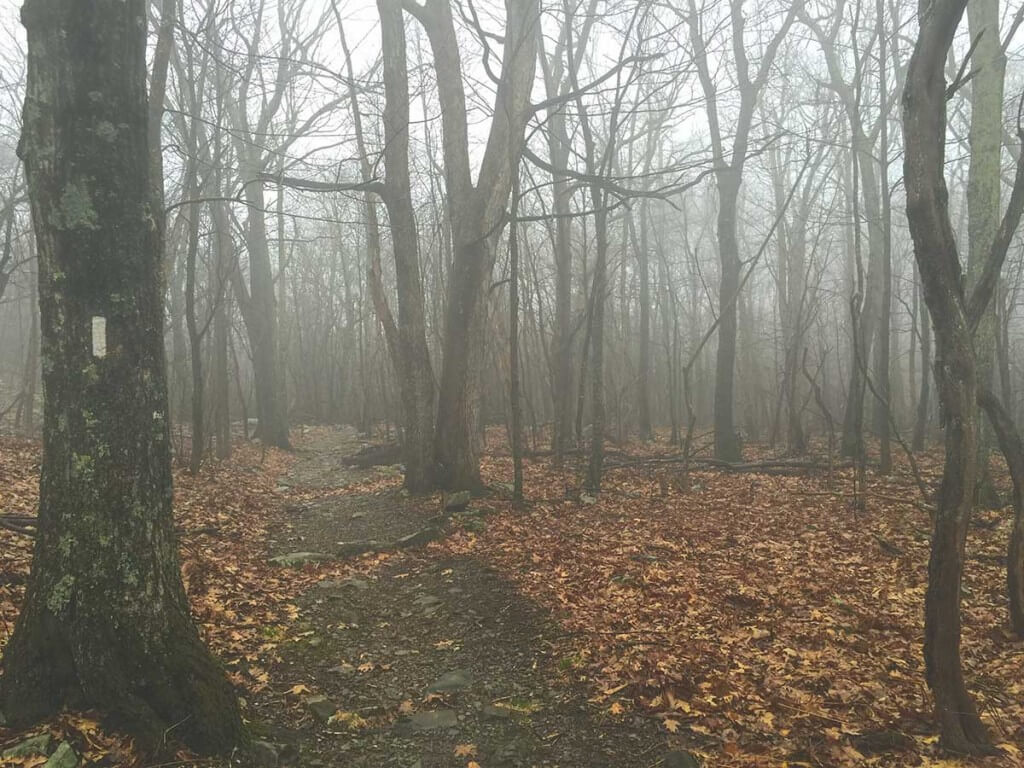
Mostly rain and mist all day along the ridge
Original (non winter modified) Practical Light Gear List
For a complete discussion on gear selection and a Complete Gear List see my previous post: Practical Light Gear List Appalachian Trail.
Original (non winter modified)5 Pound Practical Light Gear List
Click here see it full page, as a Google Sheet
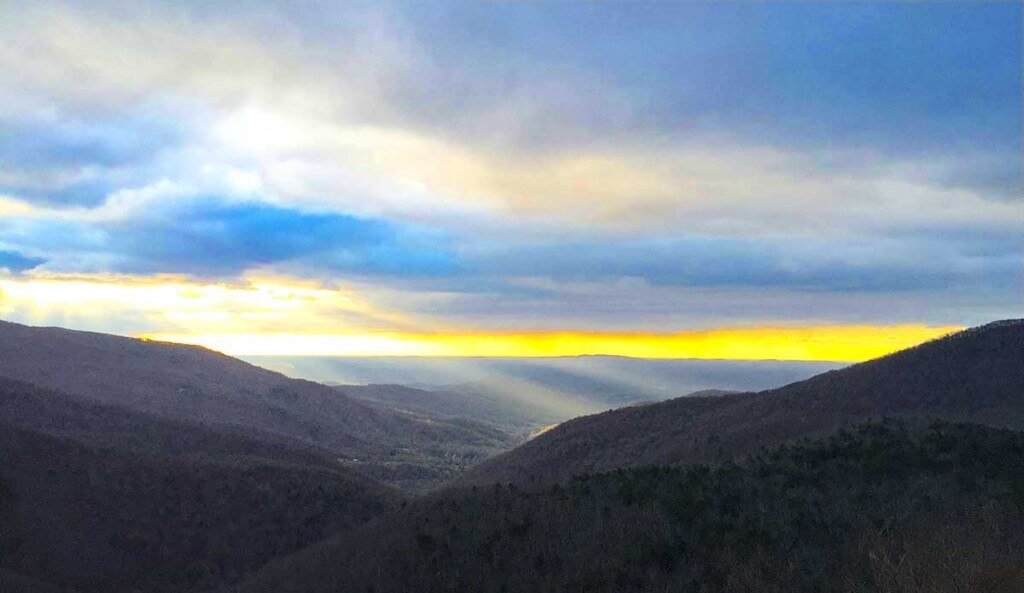
Another stunning sunrise on the Blue Ridge.
Water – Drink to Thirst
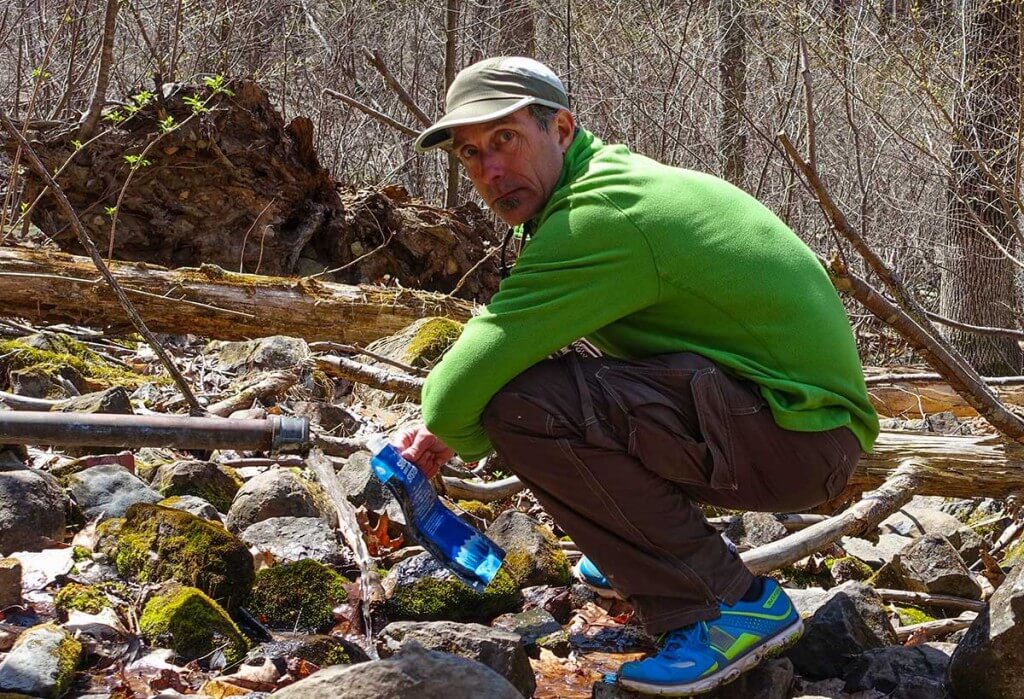
Drink to Thirst: Collecting water from springs right by the trail saves time. Drinking at the source with a Sawyer Filter means that I don’t have to carry water. I found I could easily hike to the next trailside water source without becoming thirsty.
Shakedown Trip – test out gear and legs
Shakedown trip: Two weekends before Alison and I did a 3 day trip in cold and wet spring conditions with the gear I intended to use on the hike. We got 35 degree rain, and hard freezes at night. My gear performed well and I made only a few adjustment prior to the Shenandoah. We also did one hard and fast 22 mile day to see test fitness, leg strength and endurance.
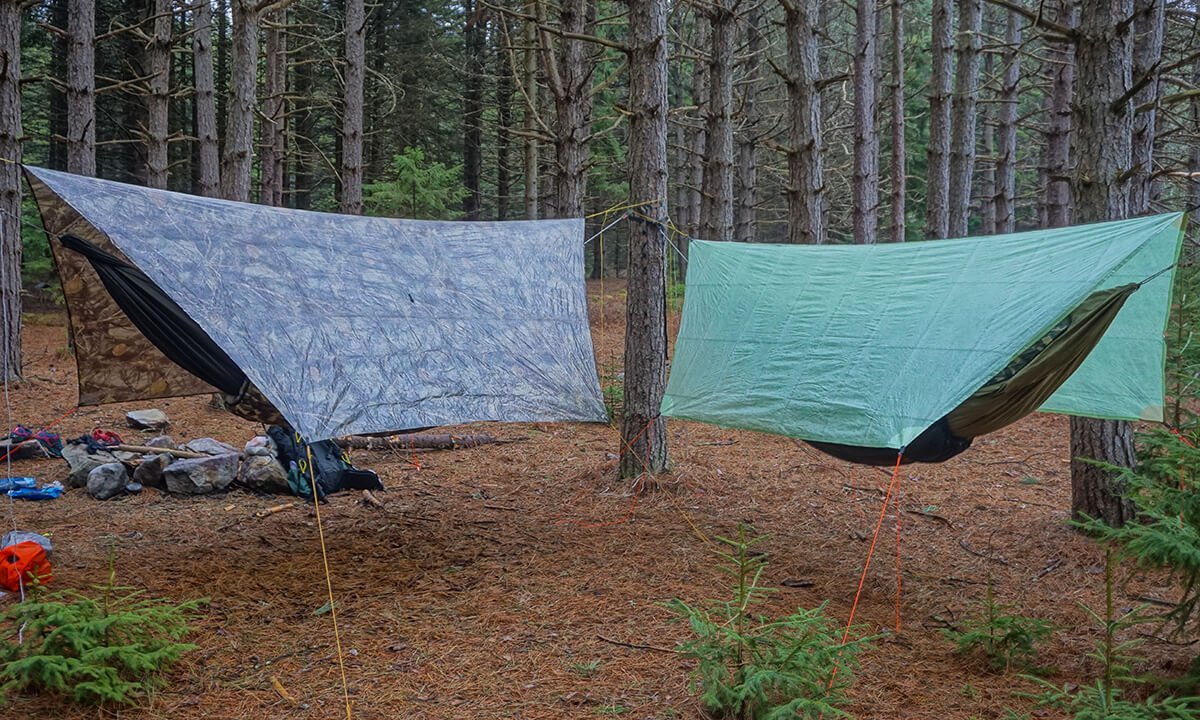
Gear testing on a shakedown trip: Warm and snug in our hammocks sheltered in grove of pines. It was 35 degrees spitting rain when we went to bed and dropped to 25 degrees by the next morning. My hammock setup is on the left: Dutchware Netless Hammock with Dutchware suspension/hardware, Hammock Gear (HG) top & bottom quilts, and HG Cuben Hex Tarp.
Parting Shot – 10 Pound Backpack to Hike 100 Miles
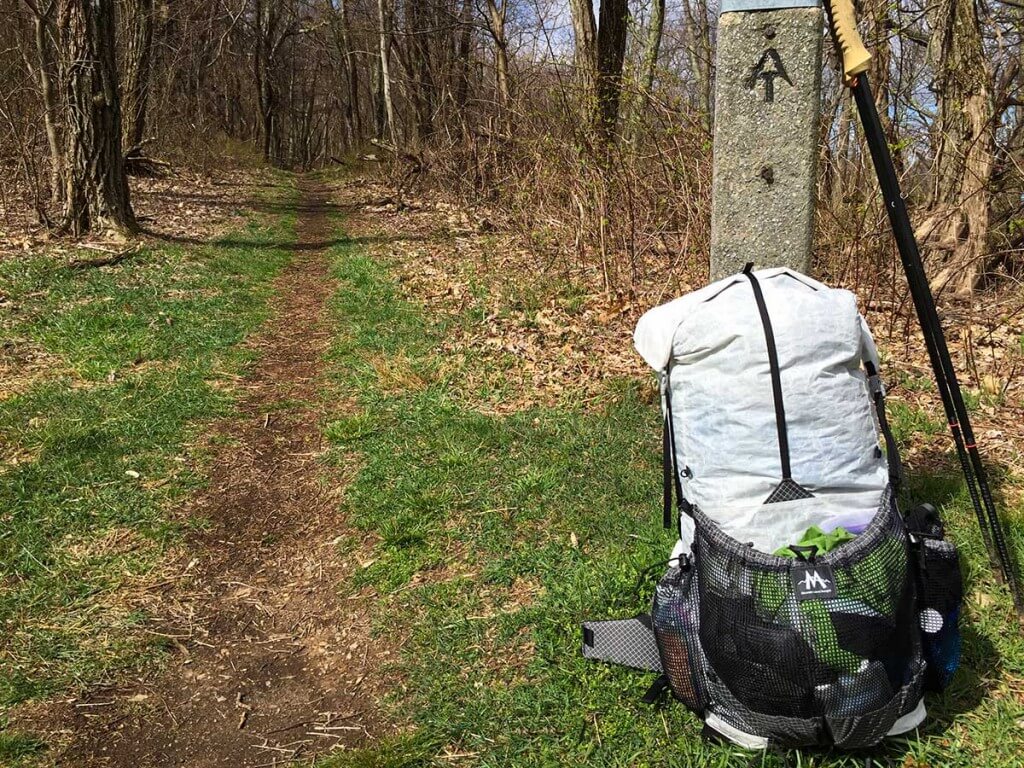
And yes, there was sunshine on this trip.

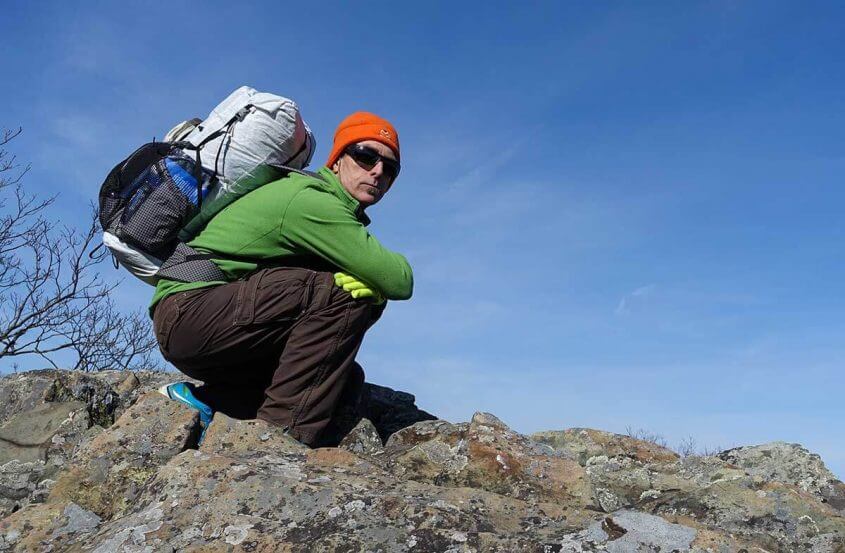
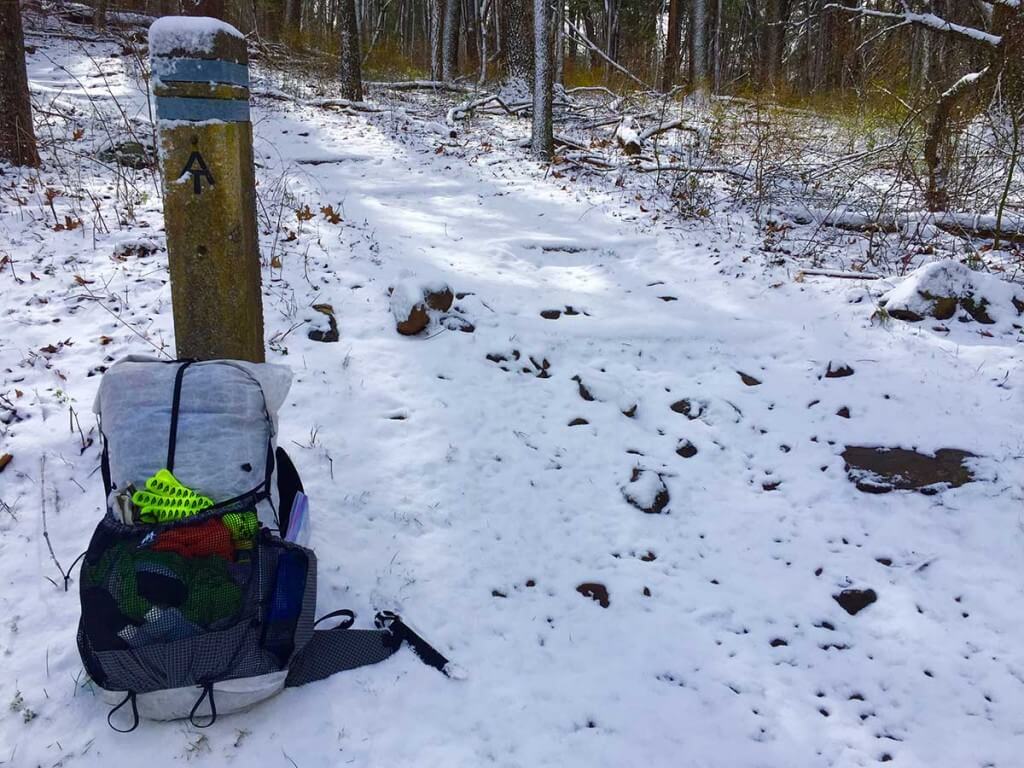
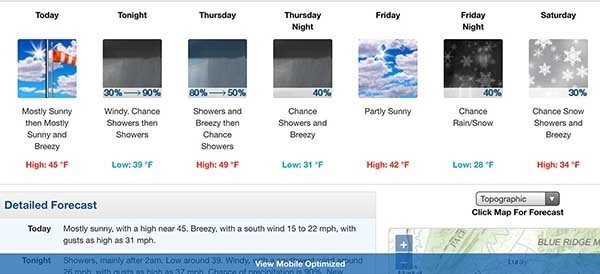
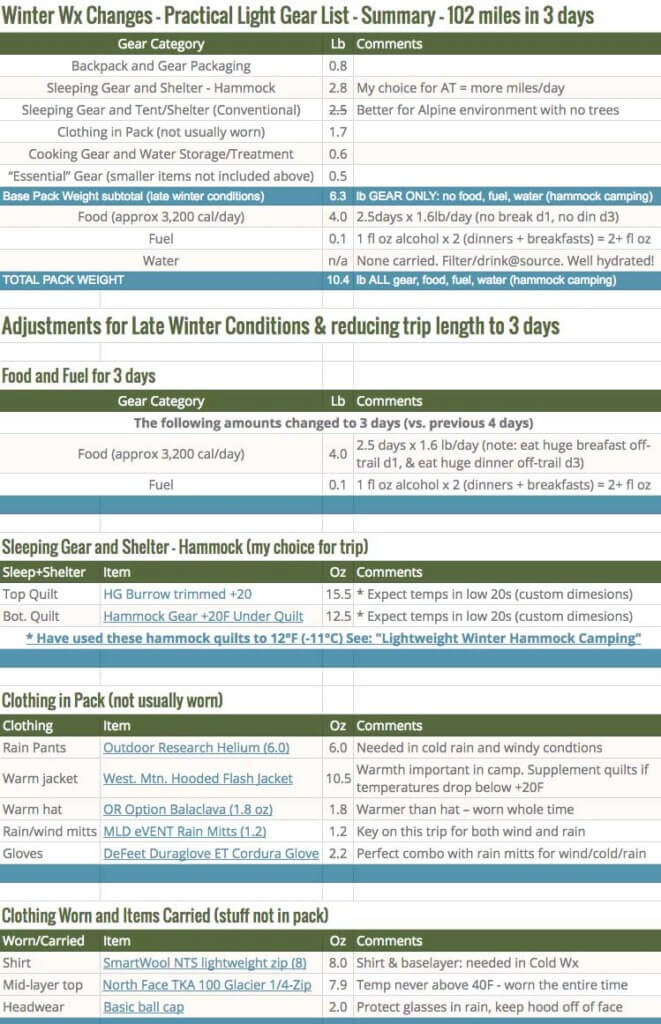
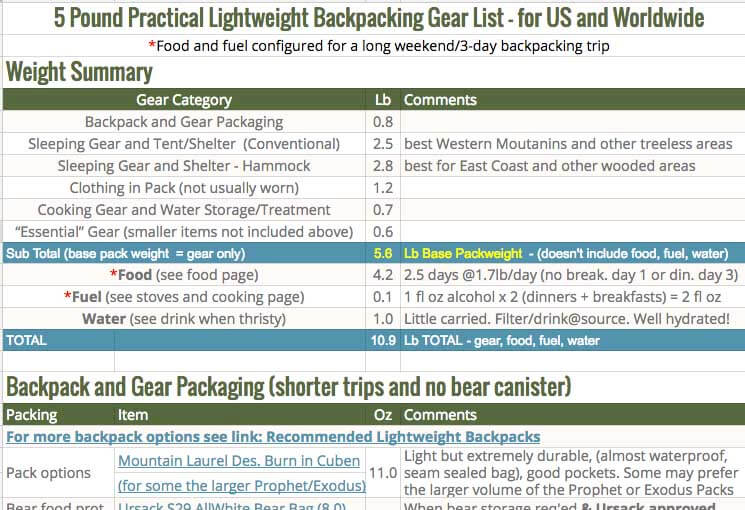


I live in N GA and love to winter hike for solitude and views. Hiking in the winter weather Alan had I would hike fast, too!. Always informative on gear and technique, Alan!
A few notes I would add for those not familiar with the area in temps a bit warmer when critters are active: Shen NP has the highest concentration of black bears on the AT. Shelters have bear cables for food bags which is big reason most overnight near a shelter – otherwise hang a food bag when stealth camping.
Warm, humid weather will increase your water consumption. In drought years, many of the small springs near ridgeline will become dry. This became a big deal on the AT in 2016. Plan accordingly.
As always, have fun!
Cheers,
Bill in Roswell, GA
Good points Bill. And yes, it was also very dry this year in Northern VA on the ridges. I think there was a 30 mile stretch near Roanoke without water. We did a hike from Roanoke to Rockfish gap and there are a number of very dry sections. At one point we had to go off trail just before dark hunting for small springs, since the last 6 water sources were all dry. Best, -alan
A case could have been made for the simplicity and less wasted set up/break down time and potentially greater wt saving approach by going to the ground using one of the lightest wt eVent WP bivies and a T-Rest Womans Neo Air maybe with a reflective Al coated SUL mylar groundsheet especially if a stiff winter breeze was expected that possibly affects temp more in a hanging set up. Although rocky in spots on the AT through S NP there are enough flat pine straw and duff areas where the small footprint of a bivy shouldn’t have been an issue looking for or pre trip determining appropriate sites especially if you’re familiar with this stretch of the AT from previous hiking. Dare I say 30+ a day avg for 3 days most would have slept well no matter if hanging or on the ground in appropriate for the conditions shelter.
Nice article. Finished this yesterday from Rockfish Gap to 522. 4 days 5 hours. Not quite the Adventure Alan pace but not bad. Used my new MLD Burn backpack. I didn’t think that it was all that small, but received several questions and comments about it, such as is that your food bag? (reply: no, it’s my everything bag), are you day hiking? Do you have a tent in there? (reply: yes, a Tarptent Protrail). I was a bit surprised that many of the AT through-hikers thought my pack was unusual. Had some inefficiency on Day 4 when I stopped at the Elkwallow camp store for a cheeseburger, fries, and 2 beers. :)
Nice Job John, that’s a very quick trip through the Shen! And nothin’ wrong with a beer on the trail :-). All the best, -alan
Good article and recommendations. I’ve twice done the Wonderland Trail around Mt. Rainier (92 miles) in two days and varied the list – no stove (no food taken required cooking), took a lightweight bivy sack and space blanket for emergency (hiked straight through without sleeping), and added a headlamp with spare batteries and a single change of socks (wore running shoes).
Impressive David. 45+ miles per day is a blistering pace. Best, -alan
Thanks. It also has about 21,000′ of altitude gain (and then loss!) in the loop, making it a great challenge. Did it while training for ultramarathons. I was in my mid-40’s at the time, my partner was 10 years older(!) Those were the days …
This seems like an excellent backpack! I have to buy one like this one!
I enjoy and am inspired to by reading your articles on your ultralight hiking experiences. I’ve been working in eastern Belgium and have managed a few day hikes in the Ardennes. But am looking forward to returning to GA and getting back on the AT. Thanks, and keep sharing.
Thanks Robert. Enjoy light hiking in Europe or North America. Warmest, -a
Alan, just want to say that it was a real pleasure meeting you and your wife at the maaha last weekend. I was the one with the two kids that were near Dutch’s setup. I’ve been studying your website, and this article (and others) I truly find inspiring. Really appreciate all the work you’ve put into this. I’ve been telling all my friends to check your site out. Looking forward for more- keep up the great work!
Thanks Ryan. It was great to meet you as well. All the best, -alan
I like your no bs, simple advice on gear. I’m no where near UL but certainly did my research and started out LW last year. I’m refining my gear as I’m gaining more experience. I truly appreciate your work Alan.
Thanks Hunt!
I am sure that if you work at it you will find the ideal pack-weight for you. After that, it’s all fun–just enjoying your hike. That’s what it’s all about. Best, -a
Hello Alan. Great article. I have failed to see your rain jacket in your gear list anywhere. Did you use your hammock tarp instead?
Glad you liked the article Gene,
The table is the body of the post is just my “Adjustments for late winter conditions.” That is, it is the gear that I took that was different from what is in the base gear list. The base gear list mos’ def’ has a rain jacket in there. Not sure where you were looking but this is the link to the base gear list. And here is the actual list item:
Clothing in Pack (not usually worn)
Rain Jacket Outdoor Research Helium II 6.4 oz From REI: less expensive than many at this weight
All the best, -alan
Hey Alan, great read! I’m also planning to do a 100-mile AT section hike this June (White Mountain traverse from Glencliff to Gorham), but shooting for 5 days. With warm temps, lean-to’s/bear boxes, and some supplemental food from huts, I’m hoping to get my pack weight with food and water close to your target 10 lbs.
What did you think of the volume on the Burn? 38L (or ~34L for main body+collar) seems overkill for 10 lbs. I’m considering a 20-25L pack, but I can’t afford cuben right now.
Sounds like a great hike! I think around 40L is ideal. Too small a pack and you spend too much time trying to jam stuff in and pry it out. And I don’t like to over compress my down. Also the diff between a 25L and a 40 L frameless pack is maybe a few ounces. Haven fun on your hike in June. Ping me back with trip highlights. All the best, -alan
I thought I was good at 16lbs for 3 days. 10lbs is awesome. I also can average 30+miles a day solo or with the right companions. I think that’s my limit for enjoying myself any more would be too much of just trying to get it done.
TJ, 30+/day is most excellent. And wonderful that you have “the right companions” to that mileage with you. Have a great season hiking, -a
Hello from Alaska! While I don’t plan on doing long hike through trips to this level, I am definitely considering a lot of the points you bring up in regards to gear selection. A lot of these tips can make any overnight backpacking trip that much more enjoyable for me. Granted, a lot of the places I like to go don’t have tree options for hammocks, but it’s ok. Still a great article with great pointers!
Nice article!
I’m planning for a thru-hike in Norway this summer, about 480 miles, and my packlist is planned using many of the same principles you have used on your hike.
Simple, hassle-free equipment save both time and work, I can choose even lighter versions for some of my stuff, but it will, in the end, not make it easier to reach my goal.
Safety, comfort and having a good time on the trail is all important for me, although I know many of my friends with mutual interest in hiking claim that these are the very thing I miss due to my light pack.
I currently do excersice with long runs two times a week and try to dayhike or do an overnighter every weekend, at least 15 miles long.
My (planned) pack will end up at about 16-17 pounds, mostly thanks to consumable factors. I resupply every fourth day, and have around 4000-4500 kcal/day to eat, so my food will be just above 2 pounds a day, and I will (at least for parts of the trip) carry half a liter of water, or about 1 lb, 2 oz.
I will have ample time every day though, as I have 3 weeks to finish, and 15 to almost 17 hours of daylight each day, so I can afford to loose a few minutes every now and then, but I prefer to take those minutes as a sleep-in in the morning. (Lazy me!) :-)
I have to hike (only?) about 23 miles/day, but plan to make an average of 25-30 miles and have a few days extra in the beautiful mountains of Jotunheimen range.
Your writings and packlists have inspired me before, and this even more!
Congrats to an amazing trip, I tip my hat. Keep writing and inspire me and a lot of other happy hikers around the world!!
Sounds like an incredible trip. I am jealous! Have a great hike, -a
Thank you, im excited about it!
Daniel
Nice work, very helpful article! Congratulations on an amazing feat!
Thank Glen! -a
Among all the articles I read regrading gear and specific hiking dynamics, this one was by a good length better in several aspects. The methodology, the specifics in gear choices, and mostly the element of time discussed in detail was exactly where I prefer the attention to be made, and where it was greatly focused.
This was, and will remain to be, a very informative synopsis for like-minded adventure.
Truly appreciated!
Thanks for the kind comments Mark. -alan